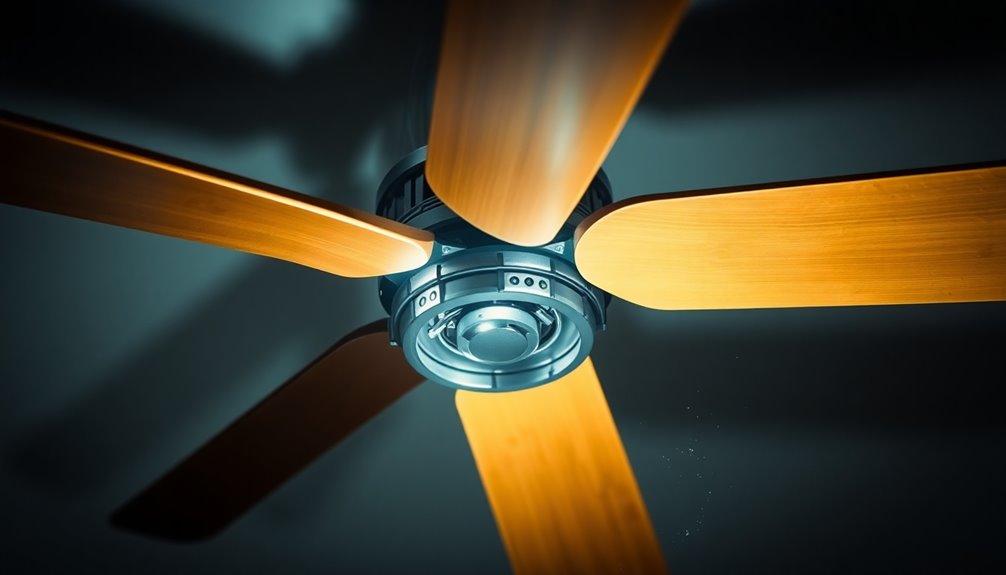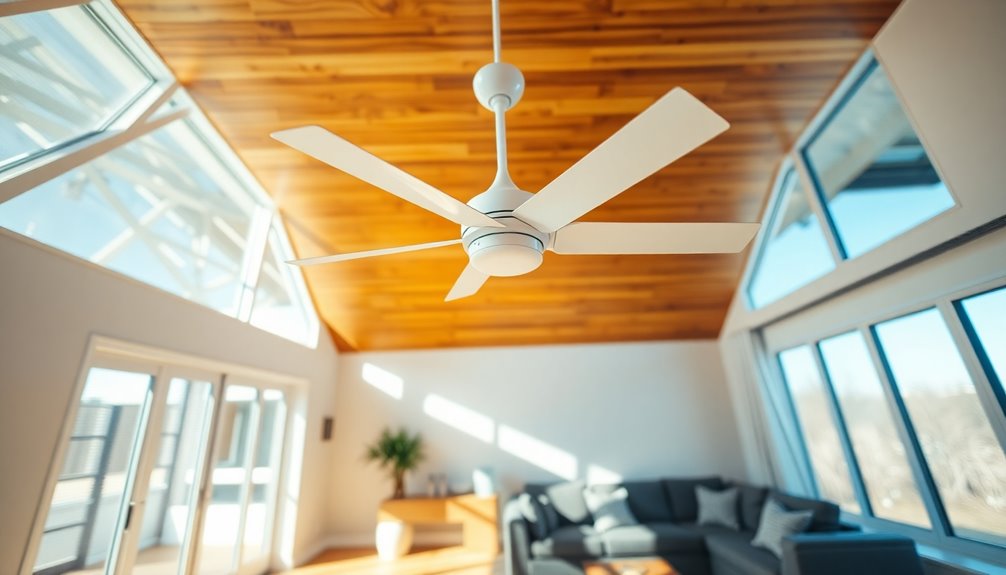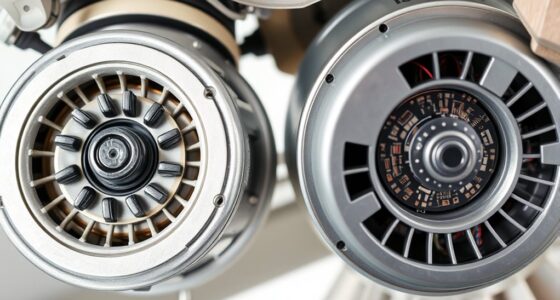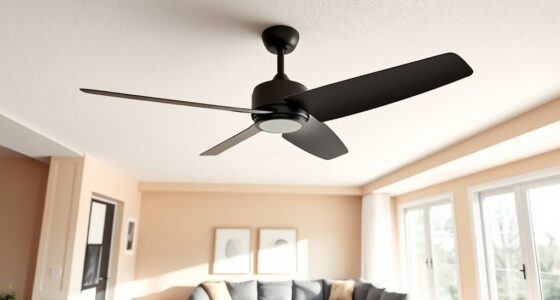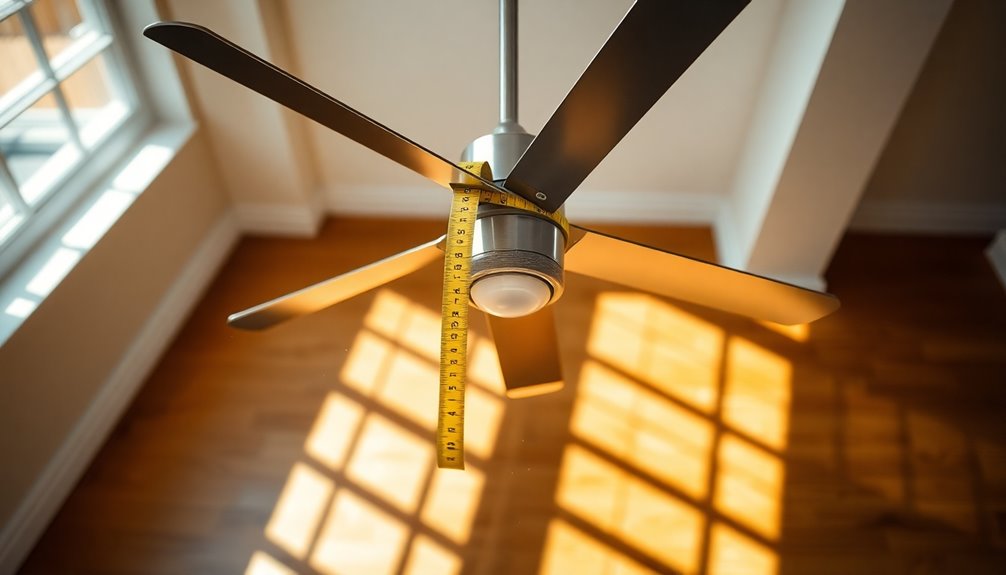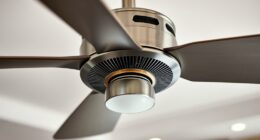A ceiling fan works by utilizing a motor to spin its blades, creating airflow that keeps your space comfortable. The angled blades employ Bernoulli's principle, maximizing air movement and helping to cool the room. When the blades spin counterclockwise, they push air down, producing a rejuvenating breeze. You can switch the direction for winter, allowing warm air to circulate more evenly. Their energy consumption is low, making them cost-effective compared to air conditioning. By maintaining your fan, you'll guarantee it runs efficiently. Discover more about optimizing your fan for seasonal use and enhancing its performance further.
Key Takeaways
- Ceiling fans operate by spinning blades to create airflow, which enhances comfort and cooling in warm conditions.
- The angled blades utilize Bernoulli's principle, increasing air velocity and promoting efficient air circulation.
- Fans can operate in two modes: counterclockwise for cooling in summer and clockwise for redistributing warmth in winter.
- Energy-efficient fans use significantly less electricity than air conditioning units, reducing cooling costs by 10-30% when paired with AC.
- Regular maintenance, including cleaning and tightening components, ensures optimal performance and safety of ceiling fans.
Principle of Operation

Understanding how a ceiling fan works involves recognizing its fundamental principle of operation. At the core, a ceiling fan utilizes a motor to spin its fan blades, creating air movement that enhances comfort. This action pushes air downward, generating a cooling effect that makes you feel more comfortable, especially during warm days.
The design of the fan blades is essential; they're typically angled to utilize Bernoulli's principle, which increases air velocity and creates lower pressure zones above the blades. This principle is what allows the fan to effectively promote evaporative cooling by facilitating the evaporation of sweat from your skin.
You can operate a ceiling fan in two modes: counterclockwise for cooling during summer and clockwise for redistributing trapped warm air in winter. This versatility makes it a useful component of a ceiling for year-round comfort.
For peak performance, you'll want to verify the installation height is just right—ideally, the blades should be positioned 7-9 feet above the floor. This height maximizes airflow, confirming that you experience the full benefits of the fan's air movement and cooling capabilities.
Key Components

A ceiling fan's effectiveness hinges on its key components, each playing an essential role in its operation. The motor is at the heart of the fan, converting electrical energy into mechanical energy, which drives the rotation of the fan blades. These blades, typically made from wood, plastic, or metal, are designed in various sizes and pitches to optimize airflow and efficiency.
To guarantee stability, the fan is attached to the ceiling using a J hook, which supports its weight. A U bolt secures the motor to the J hook, preventing any movement that could disrupt the fan's operation. Additionally, capacitors are vital for providing the electrical boost needed for the motor to start and maintain speed.
Here's a quick overview of these components:
| Component | Function | Material/Type |
|---|---|---|
| Motor | Converts electrical energy to mechanical | Electrical parts |
| Fan Blades | Create airflow and improve efficiency | Wood, plastic, metal |
| J Hook | Attaches fan to the ceiling | Metal |
| U Bolt | Secures motor to J hook | Metal |
| Capacitors | Provides electrical boost for motor | Electronic parts |
Understanding these components can help you appreciate how your ceiling fan operates effectively.
Air Circulation Mechanism

How do ceiling fans create a revitalizing breeze in your space? Ceiling fans work by using a motor that spins the blades, generating airflow directed downwards. As the blades move, they create a low-pressure zone above them, which pulls air from below, enhancing air circulation throughout the room. This process relies on Bernoulli's principle, making it an effective cooling method.
The design of the blades is essential; their pitch and rotation speed greatly influence airflow in a room. A higher pitch and appropriate speed optimize air movement, ensuring you feel that invigorating breeze.
When you turn on your ceiling fan, it increases the evaporation rate of sweat on your skin, providing a perceived drop in temperature without actually lowering the room temperature.
Moreover, ceiling fans promote destratification by mixing the warm air trapped near the ceiling with the cooler air below. This leads to more uniform temperatures in the room, making it more comfortable for you.
Cooling Effect

Ceiling fans deliver an impressive cooling effect by boosting airflow, which in turn accelerates the evaporation of sweat from your skin. This process creates a perceived drop in temperature, helping you feel more comfortable without actually lowering the room temperature.
With the right ceiling fan, the airflow generated can make a room feel up to 4°F cooler, allowing you to set your thermostat higher when using air conditioning.
The cooling effect is achieved through the principles of evaporative cooling. As the blades rotate, they create a downdraft that pushes air downward, enhancing the evaporation rate of moisture on your skin.
This constant movement of air helps to circulate air throughout the room, providing a revitalizing breeze that combats the heat.
Energy Efficiency

When it comes to energy efficiency, ceiling fans are a smart choice.
They use considerably less electricity than air conditioning units, helping you save on cooling costs while still keeping your space comfortable.
Plus, by enhancing your HVAC system's efficiency, you can enjoy year-round climate control without breaking the bank.
Reduced Energy Consumption
Using a ceiling fan can greatly cut down on your energy consumption compared to traditional air conditioning systems. Ceiling fans throughout your home typically use about 60-90 watts of electricity, while air conditioning units can consume 2,000 watts or more. By pairing energy-efficient ceiling fans with your air conditioning, you can raise your thermostat settings by up to 4°F and still feel comfortable in your home, resulting in a 10-30% reduction in cooling costs.
Here's a quick comparison of energy consumption:
| Device | Power Consumption (Watts) | Energy Savings Potential |
|---|---|---|
| Ceiling Fan | 60-90 | Up to 40% more efficient |
| Standard AC Unit | 2,000+ | 10-30% when paired with fans |
| Energy-Efficient Fan | 40% less than standard | Significant long-term savings |
Using larger ceiling fans can effectively move air at lower speeds, minimizing energy use while still providing comfort. Regular maintenance, such as cleaning the blades, guarantees your ceiling fans operate efficiently, further supporting reduced energy consumption and extending their lifespan. Additionally, high CFM ratings ensure that you achieve optimal airflow without excessive energy use.
Year-Round Comfort Benefits
For those seeking year-round comfort, ceiling fans play an essential role in enhancing energy efficiency in both summer and winter. By using a ceiling fan, you can save on energy costs considerably.
During the summer, running your fan can help cool a room more effectively, allowing you to raise your thermostat by up to 4°F without sacrificing comfort. This simple adjustment can lead to noticeable savings on your electricity bill.
In the winter, a ceiling fan can save you money by circulating warm air that gets trapped near the ceiling. Running the fan in a clockwise direction at low speed pushes air down, redistributing that warmth throughout the room.
Energy Star certified ceiling fans are particularly advantageous, as they're up to 40% more efficient than standard models, enhancing your overall energy efficiency.
Additionally, larger ceiling fans can push air at lower speeds, creating a comfortable environment while minimizing noise and energy consumption.
Enhanced HVAC Efficiency
Ceiling fans greatly boost HVAC efficiency by allowing you to adjust your thermostat settings without sacrificing comfort. You can increase your thermostat by about 4°F, which means you'll rely less on your air conditioning system. This simple change can lead to energy savings of up to 30%, as ceiling fans effectively circulate conditioned air throughout your space.
When warm air gets trapped near the ceiling, ceiling fans promote destratification. By mixing that warm air with the cooler air below, you create a more even temperature, reducing the demand on heating systems.
Using ceiling fans in occupied areas enhances HVAC performance even further, providing a cooling effect that can lower energy usage in your air conditioning units.
Opting for Energy Star certified ceiling fans is a smart move, as these models can be up to 40% more efficient than traditional fans. This efficiency translates into long-term savings on your energy bills while improving the overall performance of your HVAC system.
Maintenance Tips

Regularly maintaining your ceiling fan is essential for peak performance and longevity. Here are some key maintenance tips to keep your ceiling fans running smoothly:
| Task | Frequency |
|---|---|
| Clean blades and covers | Every week or two |
| Check screws and bolts | Every few months |
| Inspect wiring connections | Periodically |
| Adjust for wobbling | As needed |
Start by cleaning the blades and light covers every week or two to prevent dust buildup, which can hinder operation. Use a damp cloth for easy cleaning, and consider a ceiling fan cleaning spray for better dust removal. Every few months, check and tighten screws and bolts to avoid wobbling and guarantee stability during operation.
Additionally, inspect wiring connections for any signs of wear or damage to guarantee safe operation and prevent electrical issues. If you notice your fan wobbling, use a balancing kit to adjust the blades. This not only smooths out operation but also extends the lifespan of your fan. By following these maintenance tips, you'll enjoy a well-functioning ceiling fan for years to come.
Frequently Asked Questions
How Does a Ceiling Fan Work Step by Step?
To understand how a ceiling fan works step by step, first, you'll want to check the fan's motor.
When you turn it on, the motor spins the blades. As the blades rotate, they create airflow that moves downwards, cooling you off.
In summer, set it to counterclockwise for a cooling breeze, while in winter, switch it to clockwise to circulate warm air.
Make sure it's installed at the right height for ideal airflow!
How Do Ceiling Fans Cool a Room?
You'd think ceiling fans lower the temperature, but they actually don't! Instead, they create airflow that speeds up evaporation from your skin, making you feel cooler without changing the room's temperature.
By rotating counterclockwise in summer, they push air down, enhancing that breezy effect. In winter, reversing the blades redistributes warm air, keeping you cozy.
How Does a Ceiling Fan Move Air?
A ceiling fan moves air by rotating its blades, which creates a downward airflow that pushes air towards you.
As the blades spin, their design and pitch determine how much air's moved; steeper pitches usually mean more airflow.
The motor converts electrical energy into mechanical energy, powering the blades.
This effective air movement enhances your comfort, promoting evaporative cooling and making you feel cooler by increasing the evaporation of moisture from your skin.
Should Ceiling Fans Be Left on All the Time?
Sure, you could leave your ceiling fan on all the time, just like you could wear a winter coat in July.
But that'd waste energy and money, wouldn't it?
Ceiling fans work best when you're around to enjoy the airflow. They don't cool the room; they cool you.
Conclusion
To sum up, understanding how a ceiling fan works can really elevate your comfort at home. Think of it like a helpful friend on a hot day; just as they provide a revitalizing breeze, your ceiling fan circulates air to keep things cool. In fact, studies show that using a ceiling fan can lower your energy costs by up to 30%. So, next time you flip that switch, remember you're not just cooling down—you're also saving some cash!
